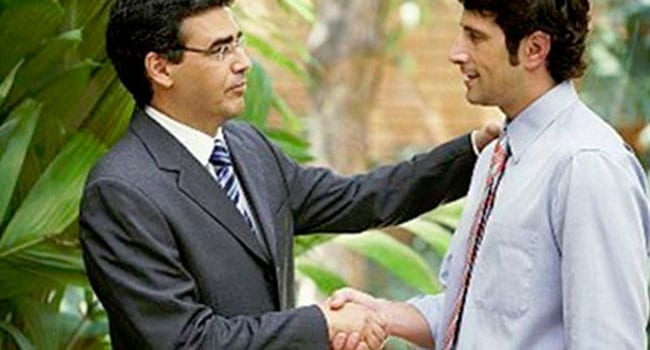 Many executives in my audiences are initially skeptical about hearing a speaker on “body language” because they suspect that the topic might be interesting, but not very practical. By the end of my program, they know better. Here’s what they learn …
Many executives in my audiences are initially skeptical about hearing a speaker on “body language” because they suspect that the topic might be interesting, but not very practical. By the end of my program, they know better. Here’s what they learn …
1) Science has validated the impact of body language
Body language is the management of time, space, appearance, posture, gesture, touch, smell, facial expression, eye contact, and vocal prosody. From the latest research in neuroscience and psychology we can now prove that body language is crucial to leadership effectiveness – and we can show exactly how it impacts a leader’s ability to negotiate, manage change, build trust, project charisma, and promote collaboration.
For example, research by the MIT Media Lab shows how subtle nonverbal cues provide powerful signals about what’s really going on in a business interaction. Whether you win or lose a negotiation is strongly influenced by unconscious factors such as the way your body postures match the other person, the level of physical activity as you talk, and the degree to which you set the tone – literally – of the conversation.
How to read body language like a pro by Carol Kinsey Goman
Based on data from devices (called Sociometers) that monitor and analyze patterns of unconscious nonverbal signals passing between people, researchers with no knowledge of a conversation’s content can predict the outcome of a negotiation, the presentation of a business plan, or a job interview in two minutes ‘” with over 80 per cent accuracy.
2) All human beings (that’s every direct report, board member, customer, contractor, and colleague) have been genetically programmed to look for facial and behavioural cues and to quickly decode their meaning.
As a species we knew how to win friends and influence people – or avoid/placate/confront those we couldn’t befriend – long before we knew how to use words. Our ancestors made survival decisions based solely on intricate bits of visual information they were picking up from others. And they did so almost instantly.We still do. Research at New York University found that we make major decisions about one another – assessing credibility, friendliness, trustworthiness, confidence, power, status, and competence – within the first seven seconds of meeting.
In business, these first impressions are crucial. Once someone mentally labels you as “likeable” or “un-likeable,” “powerful” or “submissive,” everything else you do will be viewed through that filter. If someone likes you, she’ll look for the best in you. If she doesn’t like you, or mistrusts you, she’ll suspect devious motives in all your actions. As a leader looking to make a positive first impression, you’d better know how to instantly project the nonverbal signals of warmth, candour, credibility, and confidence.
3) People evaluate body language unconsciously.
The tricky thing about body language (and one of the reasons it is so powerful) is its unconscious nature. Co-workers may form a negative opinion of you because you slouch, don’t make enough eye contact – or make too much eye contact – or stand too close to them when you speak.
But because people are unaware of how or why they made the judgment, they are unable to filter out their biases. With nonverbal communication, it’s not how the sender feels that matters most; it is how the observer perceives how the sender feels. And those interpretations are often made deep in the subconscious mind, triggered by the limbic brain, and based on a primitive emotional reaction that hasn’t changed much since humans began interacting with one another.
That’s why your nonverbal signals don’t always convey what you intended them to. You may be slouching because you’re tired, but people read it as a sign of disinterest. You may be more comfortable standing with your arms folded across your chest (or you may be cold), but others see you as resistant and unapproachable. And keeping your hands stiffly by your side or stuck in your pockets can give the impression that you’re insecure – whether you are or not.
4) Body language is how leaders express emotion.
A classic and often misquoted study by Dr. Albert Mehabrian at the University of California Los Angeles stated the total impact of a message is based on: seven per cent words used; 38 per cent tone of voice, volume, rate of speech, vocal pitch; 55 per cent facial expressions, hand gestures, postures and other forms of body language.
Why body language matters more than we may notice – Special to Troy Media
But Mehabrian never claimed that you could view a movie in a foreign language and accurately guess 93 per cent of the content by watching body language. In fact, he was only studying the communication of feelings – particularly, liking and disliking.The nonverbal aspects of communication won’t deliver 93 per cent of your entire message, but it will reveal underlying emotion, motives, and feelings. In fact, people will evaluate most of the emotional content of your message, not by what you say – but by how you say it and how you look when you say it.
5) When your body language doesn’t match your words, your verbal message is lost.
Neuroscientists at Colgate University study the effects of gestures by using an electroencephalograph (EEG) machine to measure ‘event related potentials” – brain waves that form peaks and valleys. One of these valleys, dubbed N400, occurs when subjects are shown gestures that contradict what’s spoken.
This is the same brain wave dip that occurs when people listen to nonsensical language. So, in a very real way, when your words say one thing and your gestures indicate another, you don’t make sense. And if forced to choose between your rhetoric and your body language, people will believe what they see and not what you say.
By the end of my program, leaders in the audience understand how nonverbal skills can help them develop positive business relationships, influence and motivate direct reports, improve productivity, bond with team members, present ideas with more impact, and authentically project their personal brand of charisma. They learn that body language is not only “interesting,” but also imminently practical!
Troy Media columnist Carol Kinsey Goman, PhD, is an executive coach, consultant, and international keynote speaker at corporate, government, and association events. She is also the author of STAND OUT: How to Build Your Leadership Presence.
For interview requests, click here. You must be a Troy Media Marketplace media subscriber to access our Sourcebook.
The views, opinions and positions expressed by columnists and contributors are the author’s alone. They do not inherently or expressly reflect the views, opinions and/or positions of our publication.

